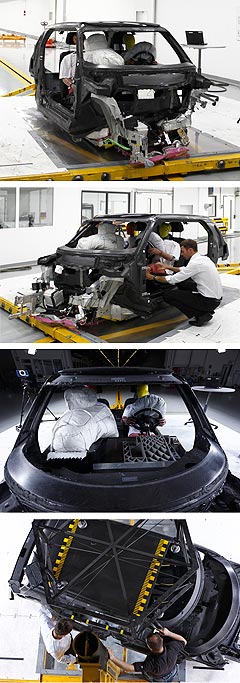Future models - BMW - i3First look: BMW sketches MegacitySketchy details: BMW's electric-powered Megacity Vehicle will have a carbon passenger cell. Megacity EV emerges as BMW offsets extra battery weight with carbon body5 Jul 2010 BMW has revealed the first image of its Megacity Vehicle (MCV), the mould-breaking new electric city car it has committed to launching under a new sub-brand in 2013. If the first official design sketch is any guide, BMW’s all-new battery-electric vehicle will be a super-compact five-door hatchback with a pronounced wedge profile. Heralded as the world’s first volume-production vehicle to feature a carbon passenger cell, the MCV should also come with almost non-existent front and rear overhangs and a fast windscreen that sweeps backwards from ahead of the front axle, leaving room for a super-snub bonnet and LED lighting elements – but there is no sign of BMW’s traditional kidney grille. BMW has already confirmed the MCV will feature extensive use of carbon-fibre-reinforced plastic (CFRP), but has now revealed details of the revolutionary new car’s ‘LifeDrive’ chassis architecture, which comprises two independent, horizontally separated modules rather than a conventional monocoque bodyshell design. At the bottom is the ‘Drive’ module that combines the battery and electric drive system with structural and crash components within a single chassis construction, while the ‘Life’ module that rides on it comprises what BMW says is a lightweight yet high-strength four-seat passenger compartment made from CFRP.  Left: BMW experimental carbon fibre vehicle platform. Left: BMW experimental carbon fibre vehicle platform.The key role of the latter, which is claimed to be as strong as steel but 50 per cent lighter than aluminium, is to offset the extra weight of the EV battery pack. “The Megacity Vehicle is a revolutionary automobile,” said BMW R&D chief Klaus Draeger. “It will be the world’s first volume-produced vehicle with a passenger cell made from carbon. “Our LifeDrive architecture is helping us to open a new chapter in automotive lightweight design. Indeed, this concept allows us to practically offset the extra 250 to 350kg of weight typically found in electrically powered vehicles.” BMW says the LifeDrive chassis/cabin arrangement – which is claimed to open the door to new production processes that are simpler, more flexible and less energy intensive – allows it to exploit the potential of its new zero (drive time) emissions drive system, which will be designed in-house by BMW. “The drive system remains the heartbeat of a car and that also applies to electric vehicles,” said Mr Draeger. “Powertrains also remain a core area of expertise of Bayerische Motoren Werke. “Electromobility and the hallmark BMW driving pleasure make an excellent match, if you go about things the right way. For this reason we are developing the powertrain for the Megacity Vehicle in-house – that includes the electric motor, the power electronics and the battery system.” BMW says it aims to produce class-leading electric drive systems that offer outstanding efficiency, performance and smoothness, as well as allowing its engineers and designers more freedom to deliver chassis agility and “a new aesthetic for sustainable urban mobility solutions”. The new BMW-developed rear-mounted drivetrain, which is expected to deliver more than 100kW, will be development of the EV drive systems seen in the limited-production Mini E and the 1 Series Coupe-based ActiveE concept. BMW has also hinted at a ‘range-extender’ version of the MCV equipped with a small-capacity engine-generator to top-up battery charge, which would be similar in concept to plug-hybrids like GM’s Volt, which will be sold in Australia as a Holden from 2012. While the ActiveE incorporated a rear-mounted 125kW/250Nm electric motor driving the rear wheels, powered by a liquid-cooled front-mounted lithium-ion battery, the Megacity hybrid could also employ a version of the three-cylinder diesel engine revealed in the scissor-doored Vision EfficientDynamics plug-in hybrid coupe concept at the 2009 Frankfurt motor show. The 1800kg 1 Series coupe-based ActiveE was said to accelerate to 100km/h in less than nine seconds. BMW said it was confident the concept’s 160km maximum driving range could be extended by up to 20 per cent, although its top speed will remain at 145km/h. Charge time from empty using a 240-volt domestic power supply is claimed to be about three hours. BMW has already confirmed the Megacity, which is expected to sire an entire model family including a sports coupe, will be produced at Leipzig in Germany, using components supplied by Bavarian joint-venture companies including SGL Carbon. Before the Megacity goes on sale in selected markets globally in 2013, BMW next month will release facelifted 3 Series Coupe and Convertible models in Australia. Then, next year, it will launch the second (F20) generation 1 Series, including front-wheel drive derivatives based on the next Mini, followed by a redesigned 6 Series range comprising a four-door grand tourer based on the Gran Coupe concept that debut at this year’s Beijing motor show.  Read morei3 pricing
Motor industry news |
Click to shareBMW modelsResearch BMW i3 pricing
Motor industry news |
















Facebook Twitter Instagram